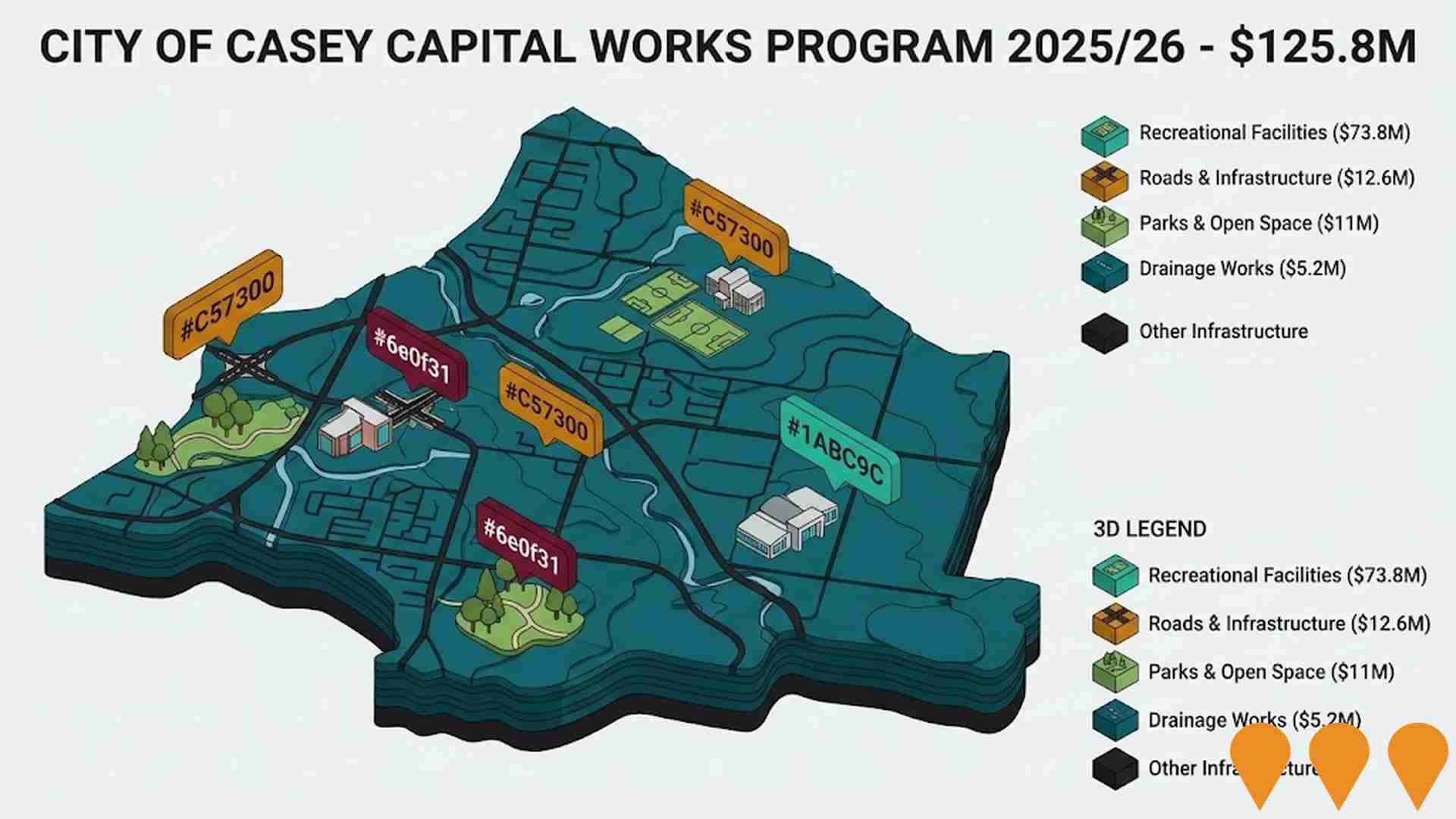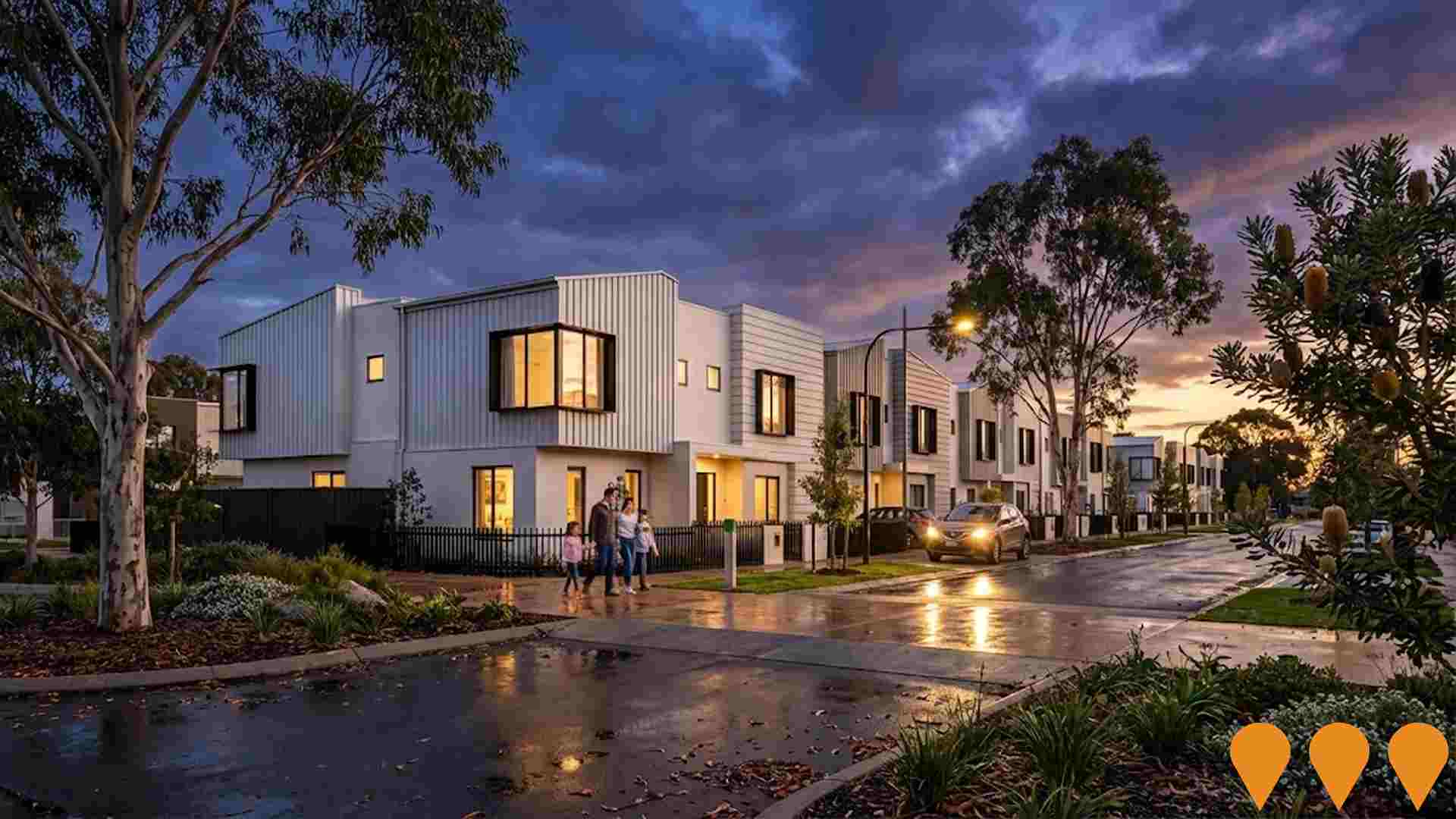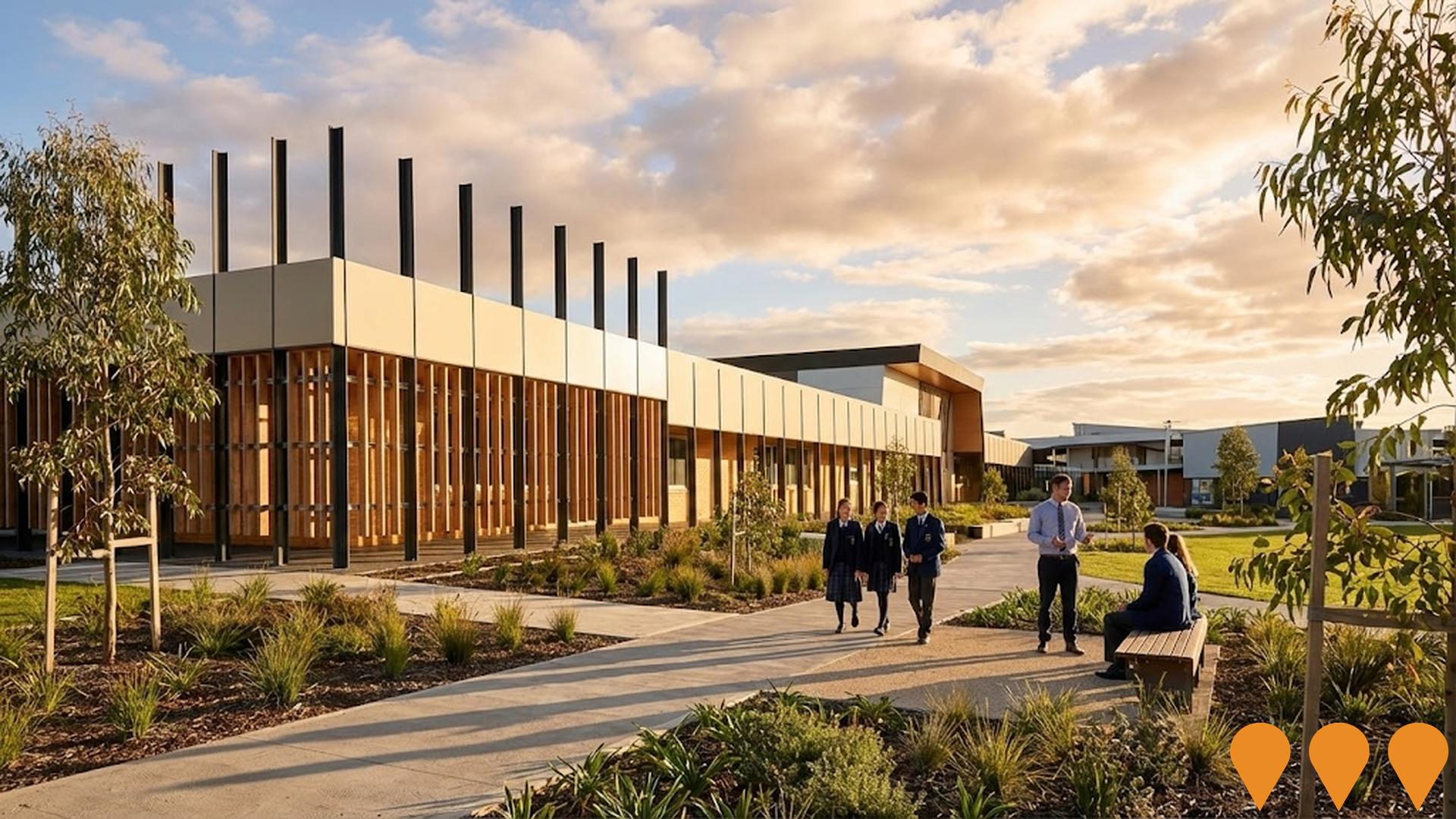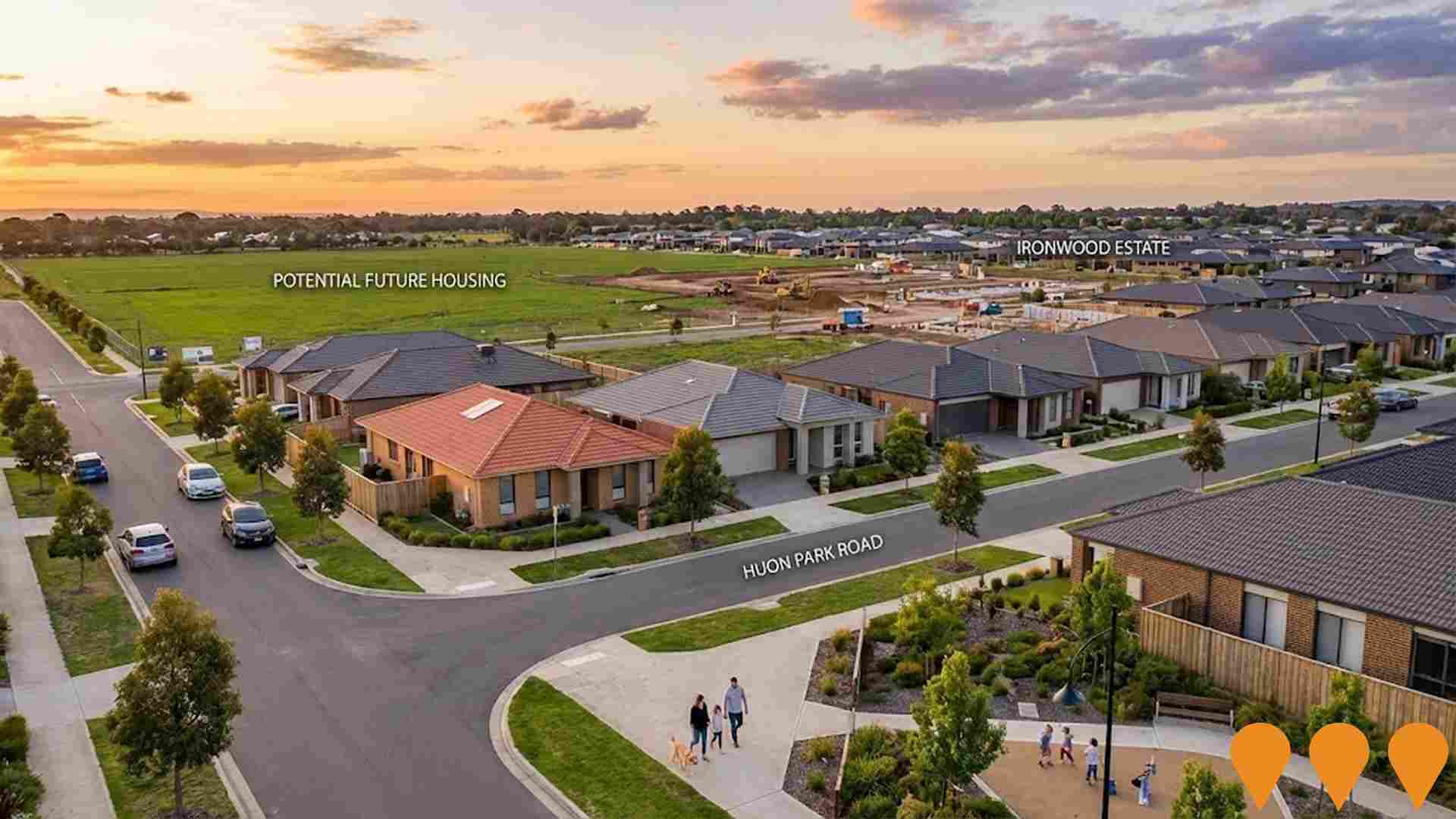Chart Color Schemes
est. as @ -- *
ABS ERP | -- people | --
2021 Census | -- people
Sales Activity
Curious about local property values? Filter the chart to assess the volume and appreciation (including resales) trends and regional comparisons, or scroll to the map below view this information at an individual property level.
Find a Recent Sale
Sales Detail
Population
Berwick - South West lies within the top 10% of areas nationally in terms of population growth performance according to AreaSearch analysis of short and medium-term trends
Based on AreaSearch's analysis, Berwick - South West's population is around 13,001 as of Nov 2025. This reflects an increase of 1,747 people since the 2021 Census, which reported a population of 11,254 people. The change is inferred from the estimated resident population of 12,791 from the ABS as of June 2024 and an additional 446 validated new addresses since the Census date. This level of population equates to a density ratio of 2,615 persons per square kilometer. Berwick - South West's growth rate of 15.5% since the 2021 census exceeded the SA3 area (6.1%) and the national average, marking it as a growth leader in the region. Population growth for the area was primarily driven by overseas migration that contributed approximately 38.5% of overall population gains during recent periods.
AreaSearch is adopting ABS/Geoscience Australia projections for each SA2 area, released in 2024 with 2022 as the base year. For areas not covered by this data, AreaSearch utilises VIC State Government's Regional/LGA projections released in 2023, adjusted employing a method of weighted aggregation of population growth from LGA to SA2 levels. Growth rates by age group are applied across all areas for years 2032 to 2041. Looking at population projections moving forward, a significant increase is forecast, with the area expected to grow by 5,224 persons to 2041 based on the latest population numbers, reflecting an increase of 38.6% in total over the 17 years.
Frequently Asked Questions - Population
Development
The level of residential development activity in Berwick - South West was found to be higher than 90% of real estate markets across the country
Berwick - South West has seen approximately 202 new homes approved annually over the past five financial years, totalling 1,013 homes. As of FY-26, 53 approvals have been recorded. On average, 1.9 new residents per year arrive for each new home built between FY-21 and FY-25, indicating a balanced supply and demand market with stable conditions. The average construction cost value of new properties is $309,000, aligning with regional trends.
In FY-26, $1.2 million in commercial development approvals have been recorded, suggesting minimal commercial development activity compared to residential. Compared to Greater Melbourne, Berwick - South West has 194.0% more construction activity per person, offering greater choice for buyers despite a recent slowdown in building activity. This high level of developer interest is significantly above the national average. New development consists of 77.0% standalone homes and 23.0% townhouses or apartments, maintaining the area's suburban character while diversifying housing options to reflect changing lifestyles and decreasing developable sites. The location has approximately 82 people per dwelling approval, indicating an expanding market with future projections showing Berwick - South West adding 5,014 residents by 2041. Based on current development patterns, new housing supply should meet demand, offering good conditions for buyers and potentially facilitating population growth beyond current projections.
Future projections show Berwick - South West adding 5,014 residents by 2041. Based on current development patterns, new housing supply should readily meet demand, offering good conditions for buyers and potentially facilitating population growth beyond current projections.
Frequently Asked Questions - Development
Infrastructure
Berwick - South West has moderate levels of nearby infrastructure activity, ranking in the top 50% nationally
Changes to local infrastructure significantly influence an area's performance. AreaSearch has identified three major projects that could impact this area. Key projects are Berwick South Development Plan, Hunt Club Village Shopping Centre Expansion, Stockland Minta Residential Estate, and Hunt Club Estate. The following list details those likely to be most relevant.
Professional plan users can use the search below to filter and access additional projects.
INFRASTRUCTURE SEARCH
 Denotes AI-based impression for illustrative purposes only, not to be taken as definitive under any circumstances. Please follow links and conduct other investigations from the project's source for actual imagery. Developers and project owners wishing us to use original imagery please Contact Us and we will do so.
Denotes AI-based impression for illustrative purposes only, not to be taken as definitive under any circumstances. Please follow links and conduct other investigations from the project's source for actual imagery. Developers and project owners wishing us to use original imagery please Contact Us and we will do so.
Frequently Asked Questions - Infrastructure
Berwick Health and Education Precinct
122-hectare master-planned precinct in Berwick delivering a major expansion of Monash Health's Casey Hospital (up to 700 beds), growth of Chisholm Institute and Federation University campuses, new private health and tertiary education facilities, plus approximately 1,030 new dwellings and commercial development centred around Berwick Station.

Hunt Club Village Shopping Centre Expansion
Expansion of Hunt Club Village neighbourhood activity centre with a new full-line Coles supermarket (3,500 m2), specialty retail, a drive-through convenience restaurant, service station and associated car parking on a 6,500 m2 vacant site. VCAT-approved in 2023, construction commenced mid-2025.
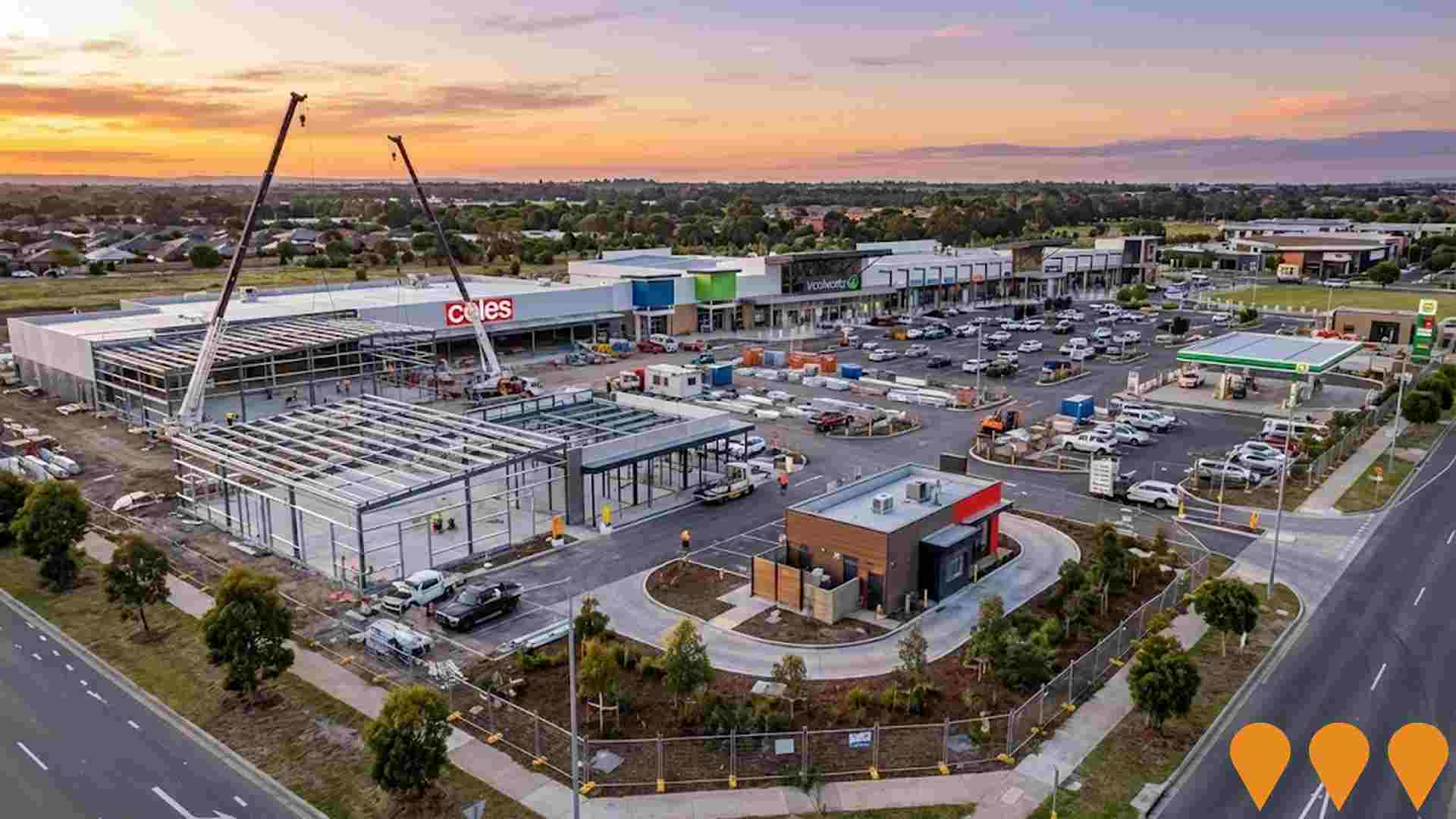
Hunt Club Estate
Master-planned community developed by Dennis Family Corporation, completed in 2015. Spans 211 hectares with 2,500 residential lots housing approximately 10,000 people. Includes Hunt Club Village Shopping Centre, primary and secondary schools, community facilities, wetlands, and a retirement village.
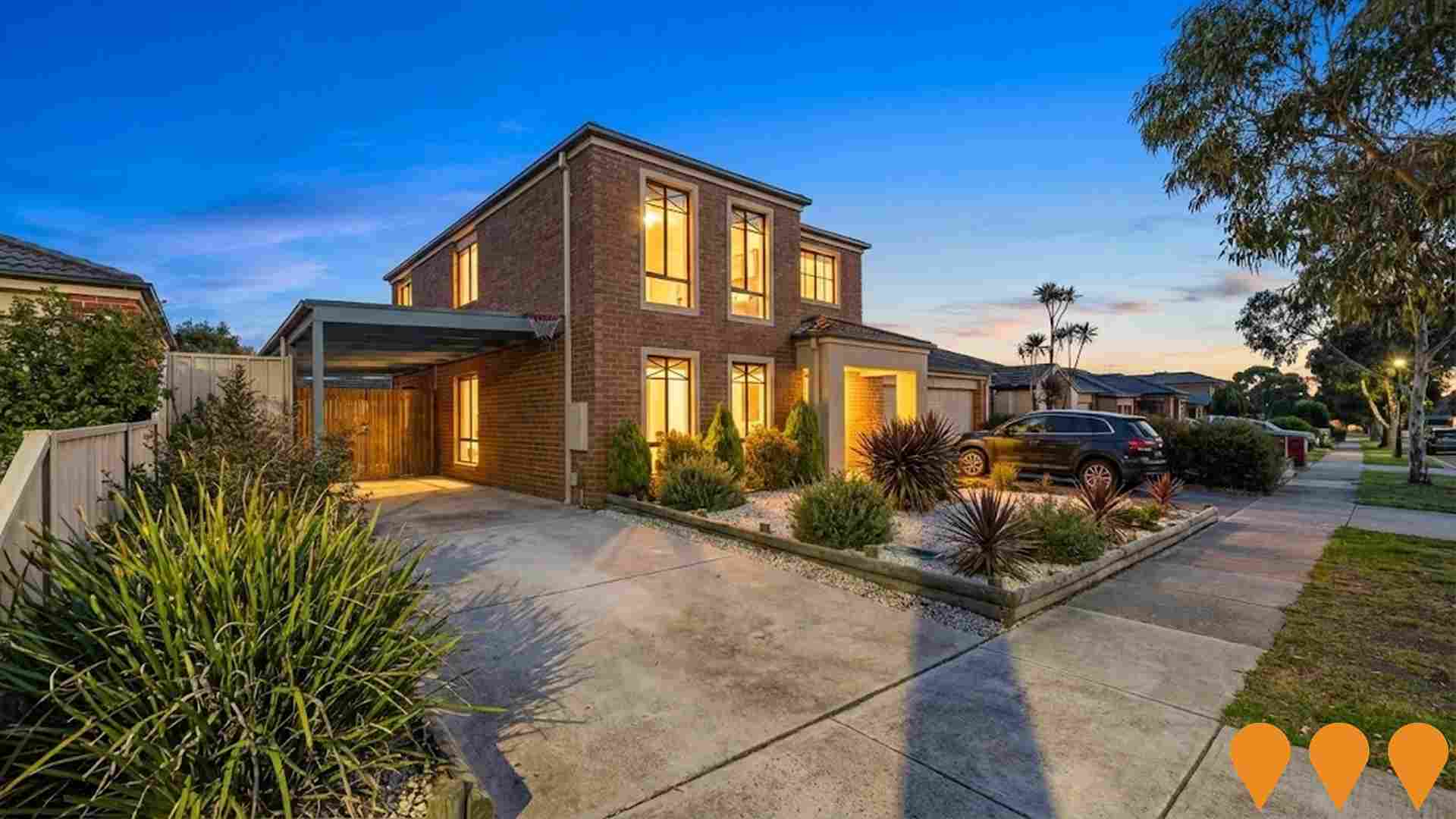
Berwick Waters
Berwick Waters is a forward-thinking master-planned community designed to nurture active and growing families. Surrounded by stunning natural landscapes and vast established wetlands, the development features waterfront homes, parks, playgrounds, schools, and a future town centre. With close to 4,000 residents already calling it home, the community offers resort-style streetscapes, extensive recreational facilities including 9km of walking and cycling paths, and is home to two new state schools opening in Term 1, 2025.
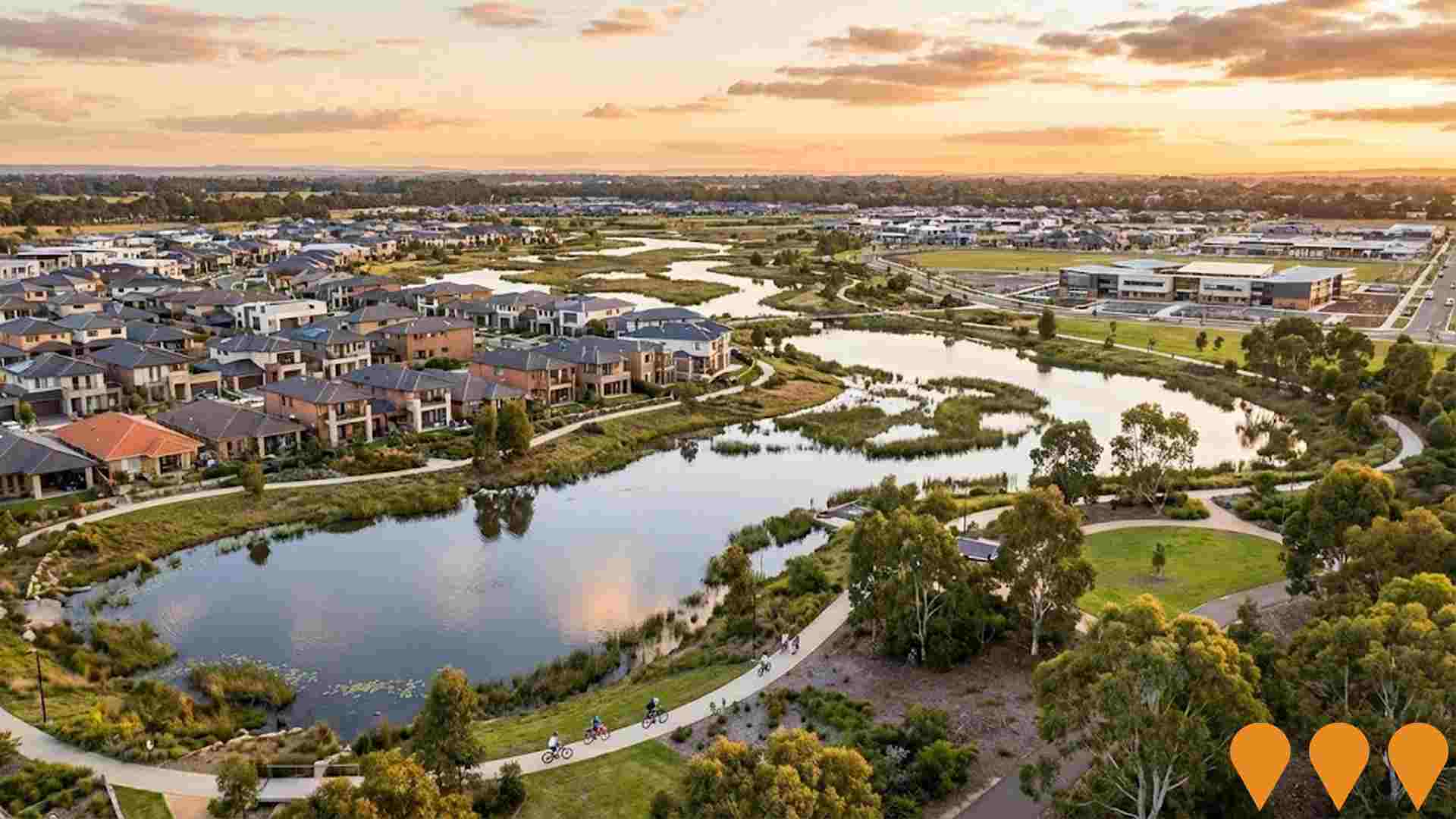
Minta
Large-scale masterplanned community by Stockland on the former Minta Farm site, covering approximately 114 hectares and planned to deliver 1,700 homes, a future town centre, schools, parks, and an employment hub that is envisioned to support around 11,000 local jobs. The estate features 22+ hectares of green open spaces and a lake-filled nature reserve, and is located in Berwick, 48km south-east of the Melbourne CBD.

Alira Village
Alira Village is a completed neighbourhood shopping centre and townhome development in the heart of Berwick. The village comprises 17 retail shops spanning 4,825 square metres including a supermarket, medical centre, gym, early education centre, and townhomes. The project is part of the larger 70-hectare Alira masterplanned community featuring wetlands, parklands and walking trails.
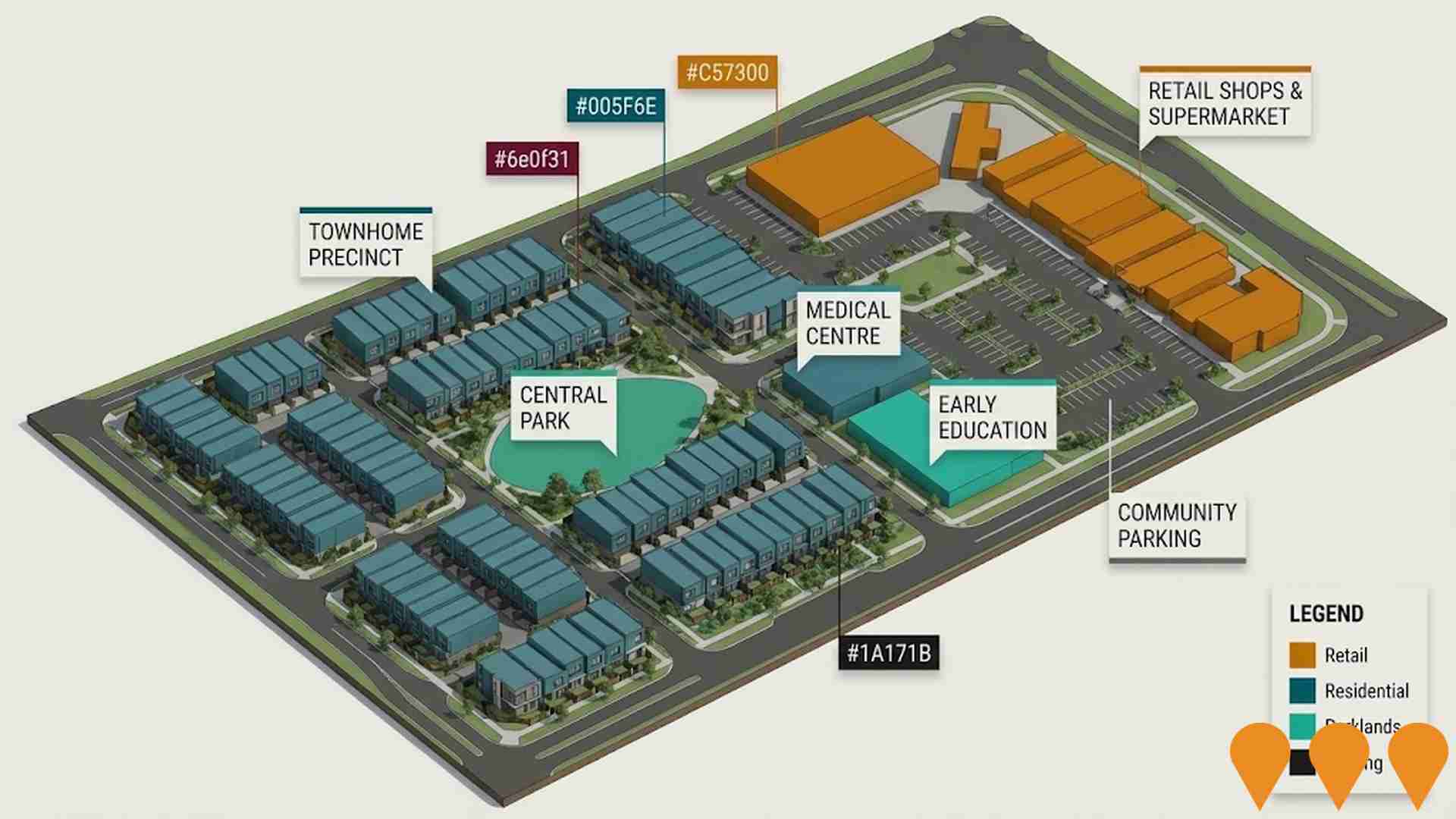
Casey Fields Sports and Recreation Complex with City Football Academy
Major regional sports complex spanning 76 hectares featuring 5 football/cricket ovals including VFL oval with 350-seat grandstand, regional athletics centre with 1,000-seat grandstand, 3 netball courts, cycling track, tennis courts, and BMX track. The complex is home to the state-of-the-art Etihad City Football Academy (opened April 2024) featuring 5 full-sized floodlit soccer pitches including hybrid turf pitch, two-story administration building, and facilities for Melbourne City FC's elite training. Future development includes a proposed 4,000-capacity Casey Mini Stadium with $10.68 million funding commitment subject to Federal Election outcome. Total complex value exceeds $30 million with recent academy addition valued at $18.7 million.
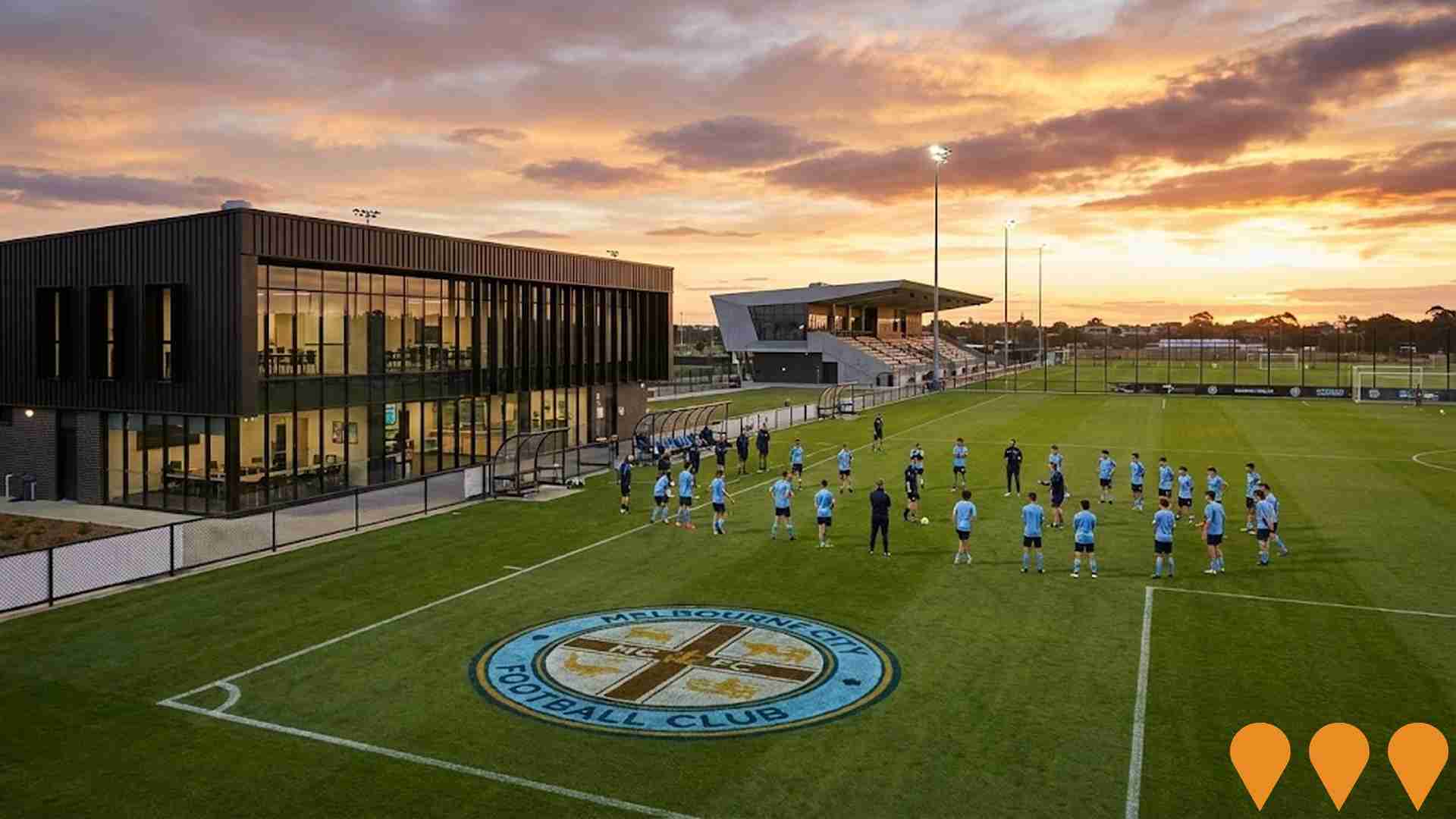
Narre Warren-Cranbourne Road Upgrade
Completed major road upgrade duplicating a 4km section of Narre Warren-Cranbourne Road from two to four (and in parts six) lanes between Thompsons Road and South Gippsland Highway in Cranbourne. Includes 10 upgraded intersections with new traffic signals, removal of roundabouts, installation of road safety barriers, new signalised pedestrian crossings, and over 9km of new shared walking and cycling paths. Major works finished ahead of schedule in 2024 (August/October). Part of the broader $2.27 billion Suburban Roads Upgrade package for Melbourne's south-east.

Employment
Berwick - South West has seen below average employment performance when compared to national benchmarks
Berwick - South West has a well-educated workforce with strong manufacturing and industrial sectors. Its unemployment rate was 5.1% in June 2024, with an estimated employment growth of 3.2% over the past year.
As of June 2025, 6998 residents were employed, while the unemployment rate was 5.0%, compared to Greater Melbourne's rate of 4.6%. Workforce participation in Berwick - South West was 71.9%, higher than Greater Melbourne's 64.1%. Leading employment industries included health care & social assistance, retail trade, and construction. Manufacturing had a notable concentration with employment levels at 1.3 times the regional average.
However, professional & technical services were under-represented at 7.9% compared to Greater Melbourne's 10.1%. Over the year to June 2025, employment increased by 3.2%, while labour force grew by 4.4%, causing unemployment to rise by 1.1 percentage points. In contrast, Greater Melbourne saw employment grow by 3.5% and unemployment rise by 0.5 percentage points. National employment forecasts from Jobs and Skills Australia, issued in May 2025, project a 6.6% increase over five years and 13.7% over ten years. Applying these projections to Berwick - South West's employment mix suggests local growth of approximately 6.5% over five years and 13.6% over ten years.
Frequently Asked Questions - Employment
Income
The area exhibits notably strong income performance, ranking higher than 70% of areas assessed nationally through AreaSearch analysis
Berwick - South West had a median taxpayer income of $55,204 and an average of $80,552 in the latest postcode level ATO data aggregated by AreaSearch for financial year 2022. This is higher than Greater Melbourne's median income of $54,892 and average income of $73,761 during the same period. Based on Wage Price Index growth of 12.16% since financial year 2022, current estimates would be approximately $61,917 (median) and $90,347 (average) as of September 2025. Census data shows that household, family, and personal incomes in Berwick - South West cluster around the 70th percentile nationally. The earnings profile indicates that the $1,500 - $2,999 bracket dominates with 42.8% of residents (5,564 people), similar to regional levels where 32.8% occupy this range. High housing costs consume 16.8% of income. Despite this, strong earnings place disposable income at the 75th percentile nationally, and the area's SEIFA income ranking places it in the 7th decile.
Frequently Asked Questions - Income
Housing
Berwick - South West is characterized by a predominantly suburban housing profile, with a higher proportion of rental properties than the broader region
Dwelling structure in Berwick - South West, as per the latest Census, consisted of 94.8% houses and 5.2% other dwellings (semi-detached, apartments, 'other' dwellings). This compares to Melbourne metro's 88.1% houses and 11.8% other dwellings. Home ownership in Berwick - South West was at 16.2%, with mortgaged dwellings at 51.7% and rented dwellings at 32.0%. The median monthly mortgage repayment in the area was $2,000, higher than Melbourne metro's average of $1,900. Median weekly rent in Berwick - South West was recorded at $400, compared to Melbourne metro's $370. Nationally, Berwick - South West's median monthly mortgage repayment exceeds the Australian average of $1,863, while median weekly rent is higher than the national figure of $375.
Frequently Asked Questions - Housing
Household Composition
Berwick - South West features high concentrations of family households, with a higher-than-average median household size
Family households account for 85.1% of all households, including 53.5% couples with children, 18.8% couples without children, and 11.9% single parent families. Non-family households make up the remaining 14.9%, consisting of 12.4% lone person households and 2.4% group households. The median household size is 3.1 people, which is larger than the Greater Melbourne average of 2.9.
Frequently Asked Questions - Households
Local Schools & Education
Berwick - South West shows strong educational performance, ranking in the upper quartile nationally when assessed across multiple qualification and achievement indicators
The area's university qualification rate is 32.4% among residents aged 15+, surpassing the SA3 area average of 25.7%. Bachelor degrees are most common at 20.1%, followed by postgraduate qualifications (9.6%) and graduate diplomas (2.7%). Vocational credentials are also prevalent, with 33.1% of residents aged 15+ holding such qualifications – advanced diplomas at 12.5% and certificates at 20.6%.
Educational participation is high, with 35.2% of residents currently enrolled in formal education. This includes 12.9% in primary education, 9.1% in secondary education, and 5.4% pursuing tertiary education. Berwick Fields Primary School serves the area, enrolling 930 students as of a recent date. The school's ICSEA score is 1041, indicating typical Australian school conditions with balanced educational opportunities. It focuses exclusively on primary education, with secondary options available in nearby areas. Local school capacity is limited at 7.2 places per 100 residents compared to the regional average of 16.0, leading many families to travel for schooling.
Frequently Asked Questions - Education
Schools Detail
Nearby Services & Amenities
Transport
Transport servicing is moderate compared to other areas nationally based on assessment of service frequency, route connectivity and accessibility
Transport analysis shows 27 active transport stops in Berwick - South West, all bus routes. These stops are served by 8 different routes, offering 1,965 weekly passenger trips combined. Transport accessibility is rated good, with residents typically located 329 meters from the nearest stop.
Service frequency averages 280 trips per day across all routes, equating to approximately 72 weekly trips per individual stop.
Frequently Asked Questions - Transport
Transport Stops Detail
Health
Berwick - South West's residents boast exceedingly positive health performance metrics with younger cohorts in particular seeing very low prevalence of common health conditions
Health outcomes data shows excellent results in Berwick - South West, particularly for younger cohorts who have a very low prevalence of common health conditions. Approximately 60% (7,774 people) of the total population has private health cover, compared to 53.6% across Greater Melbourne.
The most prevalent medical conditions are asthma and mental health issues, affecting 8.0 and 7.0% of residents respectively. 75.8% of residents report being completely free from medical ailments, compared to 72.0% in Greater Melbourne. Berwick - South West has 8.4% (1,098 people) of its population aged 65 and over, lower than the 15.7% in Greater Melbourne. However, health outcomes among seniors require more attention than those for the broader population.
Frequently Asked Questions - Health
Cultural Diversity
Berwick - South West is among the most culturally diverse areas in the country based on AreaSearch assessment of a range of language and cultural background related metrics
Berwick-South West has a high cultural diversity with 42.3% of its population born overseas and 42.4% speaking a language other than English at home. Christianity is the main religion, comprising 39.5%. Buddhism is overrepresented at 7.0%, compared to Greater Melbourne's 5.0%.
The top three ancestry groups are Other (20.5%), Australian (18.5%), and English (18.3%). Sri Lankan, Indian, and Hungarian ethnicities show notable divergences: Sri Lankan is overrepresented at 3.3% (vs regional 2.3%), Indian at 8.7% (vs 5.0%), and Hungarian at 0.5% (vs 0.7%).
Frequently Asked Questions - Diversity
Age
Berwick - South West hosts a young demographic, positioning it in the bottom quartile nationwide
Berwick-South West's median age is 34 years, which is lower than Greater Melbourne's average of 37 and Australia's national average of 38 years. Compared to Greater Melbourne, Berwick-South West has a higher proportion of residents aged 5-14 years (16.6%) but fewer residents aged 25-34 years (13.0%). Between the 2021 Census and the present day, the percentage of residents aged 55 to 64 years has increased from 8.4% to 9.2%, while the percentage of residents aged 35 to 44 years has decreased from 18.9% to 18.1%. By 2041, population forecasts indicate significant demographic shifts in Berwick-South West, with the strongest projected growth occurring among the 45 to 54 age group, which is expected to grow by 57%, adding 1,055 residents and reaching a total of 2,903.

